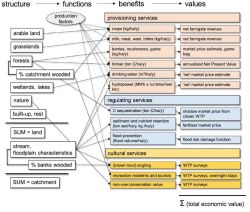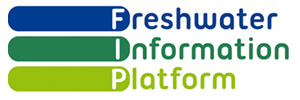An increase or decrease in woody riparian buffers along a river can have direct and cascading positive but also negative effects on different ecosystem functions of the river and its floodplain. The ecosystem services approach is used here as an integrating framework for a comprehensive assessment of the ways the river and its floodplain are beneficial to human society. These benefits can be highly disparate, for example farming revenue, flood prevention or recreational use are assessed, and their benefit is valued.
Ecosystem services is a disputed concept and criticized for "comparing apples and pears", "putting a monetary value on mother nature", but also on practical and methodological issues. In OSCAR, we were less interested in the absolute value and used ecosystem services as a framework to compare alternative future scenarios. The variation in woody riparian buffer cover (woody cover) in the floodplain was linked to variation in the provision of different services by the river and its floodplain. More information on general aspects on the use and misuse of the ecosystem services concept and more information on the specific approach used here can be found in Vermaat et al. (submitted) and Vermaat et al. (2020).
Based on the comprehensive ecosystem service classification CICES 5.1 (Haines-Young & Potschin, 2017), we first selected all 16 services related to and provided by rivers and their floodplains, taking care to prevent double-counting. The method used to assess the selected ecosystem services follows the systematic ecosystem service cascade proposed by Mononen et al. (2016) and further developed by Vermaat et al. (2020) (Fig. 1).

Fig. 1. Graphical presentation of the ‘Mononen cascade’, the analytical framework used in this study to quantify ecosystem services (from Vermaat et al. 2020).
Following Mononen et al. (2016), all ecosystem services have a spatial connotation and are related to a biophysical structure. Here, we used the different land use categories of land use data to describe the biophysical structures (e.g. forests, grassland). For each function provided by the biophysical structure (land use category), the benefits were then quantified based on the area covered and other river and landscape characteristics (e.g. tons of crop per hectar per year), and finally converted to monetary values (e.g. € per hectar per year), which can be summed as an estimate of total economic value (TEV). We grouped these services into three overall, benchmark, categories: provisioning, regulating and cultural.
In a first step, knowledge rules for the assessment of each of the 16 ecosystem services were developed, considering all relevant factors influencing the benefit and value provided by a service. For example, the recreational value of angling in mountain rivers depends on the presence of trout, but trout survival depends on shading. Therefore, the following simple rule was derived from literature to assess the effect of woody cover, trout survival and in turn the recreational value of angling: If more than half of the river length is shaded by woody cover, then trout survival is 100%, else survival declines to a residual value of 10% at zero woody cover.
In a second step, these knowledge rules were applied in four case-study catchments for different woody cover scenarios. Since the socio-economic conditions differ in the catchments, the parameter settings to convert benefits to monetary values differ and were set-up for each catchment separately. For example, the value of crop production differs between catchments depending on the type of crops cultivated in the catchments. In our value estimates we have consistently been low-end conservative when we had a range to choose from, and we tried to stay as close as possible to a net farm gate revenue, that is not a market consumer price, but net farmer benefit before tax and subsidy.
An important methodological point is that we present value estimates. These are no directly marketable commodity prices, because they are derived with widely different approaches and here generally compiled from literature and regional or national databases. Finally, we have not delineated which sectors or strata of society are currently benefitting from each of the services. This would involve a separate sociological study that is outside our current scope. It would, however, be an obvious, next step of a scenario analysis like the one done here.
The river network in the case-study catchments was divided into river segments (about 0.5-1.0 km in length) since ecosystem services can only be assessed for distinct objects. All data necessary for the assessment were attached to the river segments. Besides floodplain and river characteristics like floodplain area, river section length, and slope, land use data were quantified for the different scenarios (woody cover in the floodplain, riparian area, and 10m buffer, percentage cover of other land use categories like cropland and grassland in the floodplain).
Knowledge rules
Below, a graphical representation of the knowledge rules is given (Fig. 2). For more details on the knowledge rules, please see Table 2 and the supplementary material of Vermaat et al. (submitted).

Fig 2. Graphical representation of the knowledge rules. The box ‘human population’ reflects the major riparian communes through which the valley runs, hence the area is larger than the floodplain. Three small ‘knowledge rule’ step diagrams indicate the effect of respectively woodland cover on pest regulation expressed in crop revenue, riparian woodland cover on stream temperature, brown trout survival and hence value for angling, and of landscape heterogeneity as the percentage woodland on attractiveness for recreation (Vermaat et al., submitted).
Case-study scenario runs:
The results of the scenario runs in the four case-study catchments are described in more detail in Vermaat et al. (submitted). The main findings are given below:
"Ecosystem service value estimates are similar to values reported in literature"
The value estimates derived appear not that unrealistically far from other similar assessments, and our consistent conservative low-end approach may even have led to somewhat low values
"The overall effect of woodland cover on ecosystem service delivery appears to follow an optimum curve."
The three different categories of ecosystem services, provisioning, cultural and regulating, however, show different patterns (Fig. 3): provisioning services and cultural services were maximal around 45%, whereas this was around 30% for regulating services. Also, with increasing Strahler order, that is with increasing river size downstream the network, we see that provisioning services decrease (dominated by agriculture, dairy or crops), whereas regulating services (dominated by flood prevention) increase. Together, this apparent trade-off leads to an estimated maximal total economic value (TEV) around 40-50% woodland cover, for stream segments with Strahler order 2. It should be noted that the aggregate values averaged across the four catchments suggest that woodland cover varies between 25 and 50%, whereas the underlying individual segments range substantially wider in woodland cover: from close to zero to up to 100%. This is averaged out by the large number of segments analysed. Still, the four catchments on average have quite some riparian woodland, and that is a noteworthy result in itself.
Since ecosystem services peak at intermediate levels of woody cover, they are not fully congruent with the main functions of woody buffers like nutrient retention and shading, which are highest at maximum woody cover.
"The total economic value is surprisingly similar between scenarios."
The scenario runs show a remarkably limited effect of major changes in woodland cover on our total ecosystem value estimate (Fig. 4), even if mean woodland cover was reduced from 27% to 17% in the pessimistic scenario and increased to 70% in the ambitious scenario for the most extreme case of the lowland agricultural catchment of the Stever. Provisioning services declined with increased woodland cover and cultural services increased. Regulating services did not change that much, because they are dominated by flood prevention in our assessment.
Even very ambitious nature conservation objectives can be met with no or very limited loss in total societal benefit (TEV), i.e. without seriously compromising overall societal benefit!
"There is no simple single optimum solution maximising all services - rather depends on which balance of ecosystem services is preferred"
While TEV does not substantially differ between scenarios, the balance between different ecosystem services does. Even very ambitious nature conservation objectives can be met with no or very limited loss in total societal benefit (TEV). However, the increase in cultural services, hence appreciation by recreation including anglers, comes at the expense of provisioning services, here particularly agriculture. In the best-practice scenario, a modest increase in cultural services is combined with a slight increase in provisioning services, and hence, it appears to have a slight positive effect on the whole suite of services. We have not attempted to include any of the WFD quality elements into our assessments and hence are conservative on this issue. Therefore, if any, the best-practice scenario appears a ‘no regret’ option for river management.

Fig. 3. Aggregated effect of the percentage of woodland in the river corridor on ecosystem service delivery summed over all segments in the four river systems in the current state. The 16 services are pooled into the three MEA categories provisioning, regulating and cultural. Strahler order is used as an ordering indicator of river type, with headwater streams having order 1. All polynomial fits are significant, but only the one for total services is displayed. Figure adjusted from Vermaat et al. (submitted).

Fig. 4. Effect of changes in woodland cover due to the RMP scenarios. (a) total ecosystem service delivery expressed as Total Economic Value, (b) regulating, (c) provisioning and (d) cultural services, all plotted against the percentage of woodland for each RMP. P = pessimistic, C = current, B = best practice and A = ambitious. From Vermaat et al (submitted).
“It’s possible to carry out a comprehensive and systematic assessment of ecosystem services provided by rivers and their floodplains using the ‘Mononen-cascade’ and land use data.”
Clearly, we have derived interpretable and meaningful patterns whilst we followed the five recommendations made by a recent paper (Hanna et al., 2018): assess multiple services, use reproducible data and methods, include service interactions, select extent study area relevant to question, engage with stakeholders. Furthermore, results were comparable to other studies.
“Overall societal benefit will not decrease when woody riparian buffers are restored”
Restoring woody buffers will not lead to an overall loss of benefit or value but the increase in naturalness and cultural services will come at the expense of hard economic interests.
There are clear links with the three other functions nutrient retention, water temperature, and biodiversity since these are ecosystem services on their own or related to them. However, there are still large methodological difficulties to directly link and use results of studies on these functions in a general ecosystem services assessment. This is partly due to the different level of detail, which is greater in specific studies like nutrient models compared to services assessment that are mainly based on gross estimates.
The knowledge rules can in principal be applied in other catchments with a comparable set of services provided by the river and its floodplain. The specific socio-economic settings in the four case-study catchments limit transferability of the scenario-run results. However, some general patterns were similar across all four case-study catchments and hence, might be transferable to other Central European catchments: For example, optimum curves most probably have their maximum at moderate levels of woody cover.
Moreover, agricultural production, flood protection, and recreation generally seem to be the most important provisioning, regulating, and cultural service, respectively. However, the specific conditions in each catchment strongly influence the results like drinking water production only occurring but being an important service in the lowland Stever catchment. Finally, comparability of results strongly depends on the use of a consistent set of assumptions and input data (e.g. comparable farming and forestry statistics), which was consistent in OSCAR but might differ in other studies.
Haines-Young R., Potschin M.B. (2010). The links between biodiversity, ecosystem services and human well-being. In: Raffaelli D.G., Frid C.L.J. (eds), Ecosystem ecology: a new synthesis, pp. 110–139. Cambridge University Press, Cambridge, UK.
Hanna D.E.L., Tomscha S.A., Dallaire C.O., Bennett E.M. (2018). A review of riverine ecosystem service quantification: Research gaps and recommendations. Journal of Applied Ecology 55: 1299-1311.
Mononen L., Auvinen A.P., Ahokumpu A.L., Rönkä M., Aarras N., Tolvanen H., Kamppinen M., Viiret E., Kumpula T., Vihervaara P. (2016). National ecosystem service indicators: measures of social-ecological sustainability. Ecological Indicators 61, 27-37.
Vermaat J.E., Immerzeel B., Pouta E., Juutinen A. (2020). Applying ecosystem services as a framework to analyse possible effects of a green bio-economy shift in Nordic catchments. Ambio. https://doi.org/10.1007/s13280-020-01348-2
Vermaat J.E., Piffady J., Putnins A., Kail J. (submitted). The effect of riparian woodland on ecosystem service delivery by the river floodplain‑ a scenario assessment.
This research has been funded through the 2015-2016 BiodivERsA COFUND call for research proposals, with the national funders German Federal Ministry of Education and Research (01LC1618A), Agence National de la Recherche (ANR-16-EBI3-0015-01) and Research Council of Norway (268704/E50). OSCAR project website




